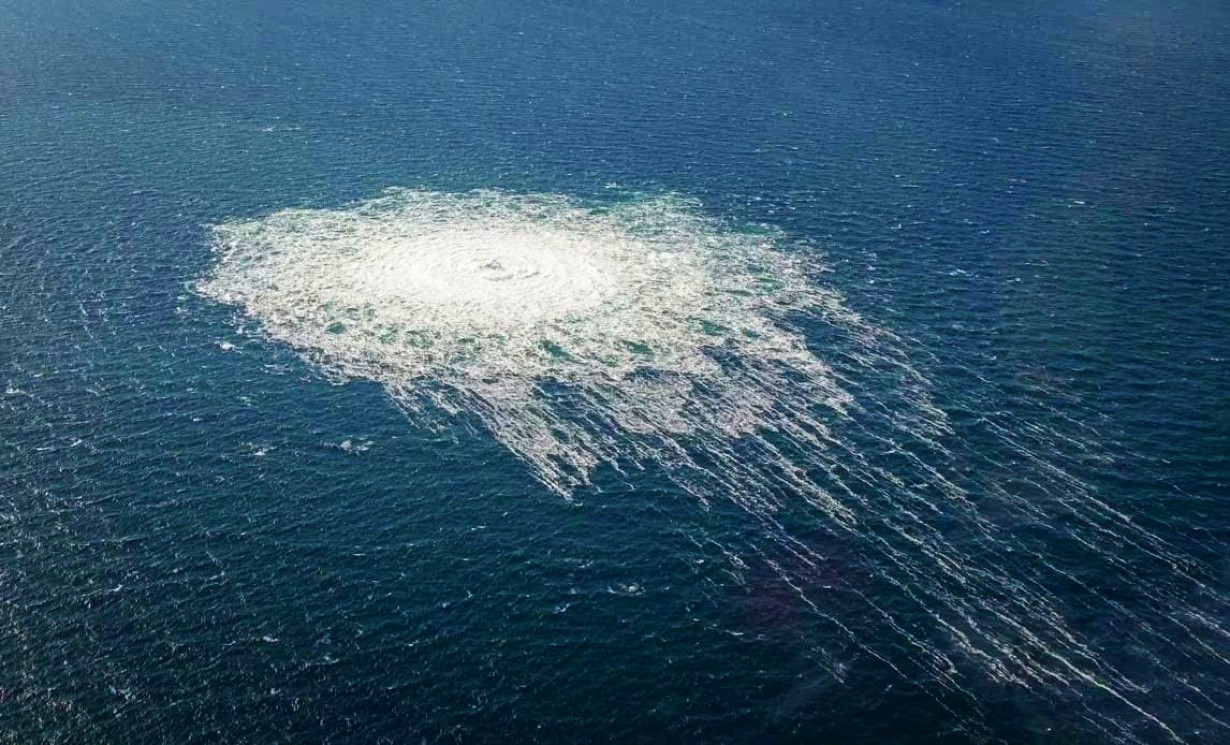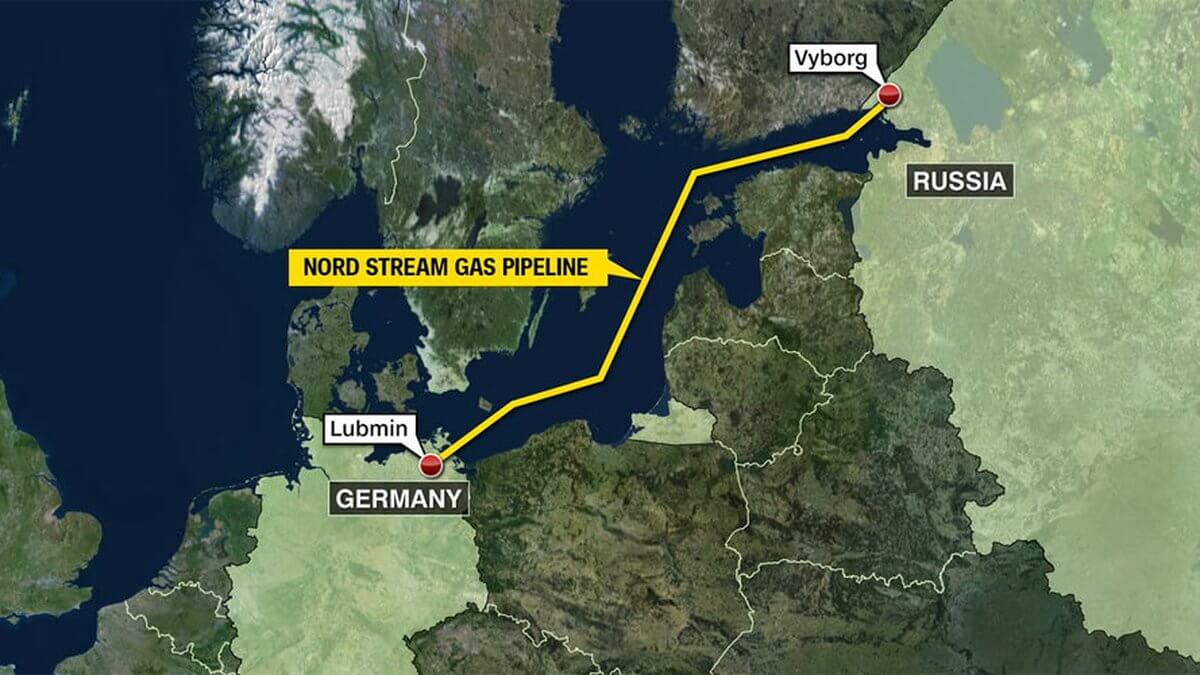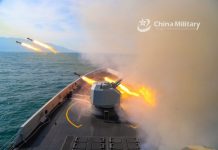The mystery over the explosions of the Nord Stream 1 and 2 pipelines in the Baltic Sea, which carry gas from Russia to Europe, early on September 26, continues with Russia and the US-led Western countries accusing each other of the “sabotage.”
Though closer scrutiny of the developments makes one ask more questions to the West than Russia about the explosion, this piece is not meant to point the finger conclusively against any country for accountability. It is just an attempt to bring some versions of the incident that have been underplayed in the global media.
It may be noted that Nord Stream 1 was completed in 2011, while work for Nord Stream 2 began in 2018, following the same track around Bornholm Island (the lines are next to each other) and was completed in September 2021.
The two lines were built by the Russians and are primarily owned by them. They must have spent billions of dollars in constructing them. Gazprom, the state-owned Russian firm, has a majority stake in the pipelines.
The gas that escaped from the explosions was believed to be worth some $600 to $800 million. Meanwhile, gas leaks from “Nord Stream 2” stopped on October 1 and from Nord Stream 1 on October 2. However, their eventual repair, highly unlikely under the present circumstances, is different.
Incidentally, gas supply through Nord Stream 2 was suspended by Germany in February, shortly before Russia invaded Ukraine. In a sense, it was not operational because as Germany was about to receive gas from this line, the Russian invasion of Ukraine took place, resulting in its suspension under protest.
But Nord Stream 1 continued to pump gas to Europe even after the invasion. During the war in Ukraine, Russia did not stop to deliver gas to Europe as contractually agreed.
Instead, Poland, Ukraine, and Germany have blocked overland and sub-sea pipelines that brought gas to Germany.
Gas supply through Nord Stream 1 was stopped by Germany only on August 31, when because of US sanctions against companies doing business with Russians, Siemens (a German company) was prevented from maintaining its compressor turbines in the pipeline as per agreement with Gazprom.

The NATO countries led by the US strongly believe that the explosions were caused by Russian underwater drones, though none of them has stated that officially. Sweden, under whose economic zone the blast took place, has completed the investigation and only says it was “sabotage.”
The statement of the Security Service of Sweden dated October 6 read, “Inspection of the scene conducted by the security police at the “Nord Stream 1” and “Nord Stream 2” gas pipelines has been completed. The investigation strengthened suspicions of gross sabotage. It has not named any country for sabotage.
The Americans also say the same. The cause was “apparent sabotage,” said Jake Sullivan, America’s national security adviser. It was “deliberate, reckless, and irresponsible,” declared NATO.
But, will the Russians damage their property, and that too a property which gives them enormous geopolitical advantages vis a vis the Americans? One, it fetches the Russians billions of euros. Until August 31, the Europeans bought Russian gas despite the US sanctions.
Two, given the critical dependence of the Europeans, particularly the Germans, on Russian gas, these pipelines weaken the European resolve to fight against Moscow for a long time under US pressure.
For instance, the latest RadioGenova tweet says: “Sanctions on Russia have destroyed European businesses and families. The Germans understood this and protested daily against Ursula von der Leyen and the EU, our real enemies who said seven months ago: “In ten days, Russia will go bankrupt!” In the end, we Europeans went bankrupt”.
Going by @RadioGenova, on September 25, “Thousands of people in Gera in Germany (protested) against Olaf Scholz’s policy and the explosion of energy and gas prices. They demand an end to sanctions on Russia and the reopening the Nord Stream 2 gas pipeline. Demonstrations also in other German cities, but EU media censors them.”
And interestingly, a day after these protests, Nord Stream pipelines were sabotaged.
Concerning the theory that a Russian underwater drone hit the pipelines and caused the leak, available literature suggests that it is highly unlikely, given the Nord Streams’ proven strength.
The steel pipe has a wall of 4.1 centimeters (1.6 inches) and is coated with another 6-11 cm of steel-reinforced concrete. Each section of the pipe weighs 11 tons, which goes to 24-25 tons after the concrete is applied.
Besides, the Baltic Seas have been under the strictest control of NATO since last June. It is to be noted that under the leadership of the US Sixth Fleet, the NATO navies conducted a very powerful “BALTOPS 22 maneuver” in June and July.
“BALTOPS, with the high degree of complexity, tested our collective readiness and adaptability while also highlighting the strength of our Alliance and resolve in providing a maritime domain with freedom of navigation for all,” Vice Adm. Gene Black, commander, US Sixth Fleet and Naval Striking and Support Forces NATO (STRIKFORNATO) had said.
From the staff’s headquarters in Oeiras, Portugal, Rear Adm. James Morley, STRIKFORNATO deputy commander, was responsible for ensuring participants met all training objectives, which included mine-hunting UUVs, persistent Intelligence, Surveillance, and Reconnaissance from an observable UAV, or demonstrating the value of the emerging Marine Corps concept of Expeditionary Advance Base Operations (EABO),” all mine countermeasures operations and replenishments at sea.
Fourteen NATO allies and two NATO partner nations, Finland and Sweden, participated in the Baltic Operations exercise (BALTOPS 22) with over 45 ships, more than 75 aircraft, and 7,500 personnel.
In support of BALTOPS, US Navy 6th Fleet partnered with US Navy research and warfare centers to bring the latest advancements in an unmanned underwater vehicle mine-hunting technology to the Baltic Sea to demonstrate the vehicle’s effectiveness in operational scenarios.
Now, with the Baltic Sea under total control of NATO, whose navies had energized themselves so well in a mammoth exercise that lasted nearly two months, could the Russian underwater drone, allegedly damaging the pipelines, have remained undetected?
And that too, when an expeditionary detachment of US Navy ships led by the universal amphibious assault ship USS Kearsarge was in the Baltic Sea, just 30 kilometers from the site of the alleged sabotage on the Nord Stream-1 gas pipeline and 50 kilometers from the threads of Nord Stream-2 gas pipeline?
These are difficult questions without any definite answers. And that explains why Russian President Vladimir Putin has accused the United States and its allies of blowing up the Nord Stream pipelines.
“The sanctions were not enough for the Anglo-Saxons: they moved onto sabotage,” Putin has said, adding, “It is hard to believe, but it is a fact that they organized the blasts on the Nord Stream international gas pipelines. They began to destroy the pan-European energy infrastructure. It is clear to everyone who benefits from this. Of course, he who benefits did it.”
Russian Foreign Ministry spokesperson Maria Zakharova has claimed that the attacks occurred in “countries that are completely controlled by the US intelligence services.” In any case, the Russians have always suspected that the US opposed Nord Stream for a long time because it was not only “very profitable for Russia” but also made Russia and Germany “more intertwined.”

However, the Americans dismiss all this as “Russian propaganda and disinformation.” But then, as Fox News television personality Tucker Carlson has explained, much against the otherwise consensus on the part of the US media and experts, Russian allegations need to be taken seriously as “If you are Vladimir Putin, you would have to be a suicidal moron to blow up your energy pipeline.” Carlson says, “That’s the one thing you would never do.”
Carlson points out that it is impossible for the Russians to misinform “the Americans in America” since anything from the Russian government is not on Google. Of course, any book sympathetic to Putin has been banned on Amazon. “Every piece of information that reflects the modern Russian point of view has been censored in the United States,” he argues.
On the contrary, Carlson has reminded some vital and well-known US policies on Nord Stream pipelines through video clips :
One is a video clip on ABC News of President Biden saying: “If Russia invades, that means tanks or troops crossing the border of Ukraine again, then there will no longer be a Nord Stream 2. We will bring an end to it.”
Reporter: “But how will you do that, exactly, since…the project is in Germany’s control?”
Biden: “I promise you, we will be able to do that.”
Two, Carlson shows a video clip of an interview with Jeffrey Sachs, Professor, Columbia University, on Bloomberg :
Sachs: The destruction of the Nord Stream pipeline, which I would bet was a US action, perhaps US and Poland …
BLOOMBERG HOST: Jeff, we’ve got to stop there. That’s quite a statement as well. Why do you feel —
Sachs: Absolutely.
BLOOMBERG HOST: That that was a US action? What evidence do you have of that?
Sachs: Well, first of all, there’s direct radar evidence that US helicopters, military helicopters that are typically based in Gdansk, were circling over this area. We also had threats from the United States earlier this year that, one way or another, we will end Nord Stream. You’re not allowed to say these things in the West, but the fact of the matter is, all over the world, when I talk to people, they think the US did it, and by the way, even reporters and our papers that are involved tell me privately, “Well, of course.” Well, it doesn’t show up in our media.
Incidentally, this interview was abruptly stopped, with the anchor getting instruction from the control room, “Stop him. Stop him.” What evidence do you have? Well, there’s radar evidence, says the interviewer. “What? Be quiet. Shut up. Just cut him off. Never invite them back. Stop.”
Incidentally, Prof. Sachs’ mention of Poland has a history behind it. In 2021, when the Nord Stream 2 was still being built, the Polish Navy interfered and endangered the pipe-laying vessels in the same place where the explosion occurred. And once the Ukraine crisis began, Poland decided against receiving Russian gas. It closed the Yamal pipeline that transports natural gas from Russia to Germany.
Ironically, however, Poland consumed Russian gas by receiving it from Germany, which, in turn, got it through the Nord Stream I pipeline from Russia! Meanwhile, Poland and Denmark built a new sub-sea pipeline that connects it to the pipeline that brings Norwegian gas to the Netherlands and Europe.
This Baltic Pipe has a capacity of 10 billion cubic meters per year (The Nord Stream system, on the other hand, could carry up to 110 billion cubic meters per year). And significantly, this pipeline opened on September 26, the same day the Nord Stream system was sabotaged.
Notably, John Helmer, the longest continuously serving foreign correspondent in Russia and who has been an advisor to government heads in Greece and the United States (under President Carter), believes that munitions to blow holes in the Nord Stream I and Nord Stream II pipelines on the Baltic Sea floor, near Bornholm Island, were fired by the Polish Navy and special forces, planned and coordinated with US intelligence and technical support; and approved by the Polish Prime Minister Mateusz Morawiecki.
Moreover, Radosław Sikorski, a former Minister of Defense and Foreign Minister of Poland and now a Member of the European Parliament, had posted a picture of the gas escaping the damaged Nord Stream pipelines and “thanked the US for blowing them up.”
However, as pointed out at the outset, the above is a collection of the currently available facts. Readers can draw their conclusions from them.
- Author and veteran journalist Prakash Nanda has been commenting on politics, foreign policy on strategic affairs for nearly three decades. A former National Fellow of the Indian Council for Historical Research and recipient of the Seoul Peace Prize Scholarship, he is also a Distinguished Fellow at the Institute of Peace and Conflict Studies. CONTACT: prakash.nanda@hotmail.com
- Follow EurAsian Times on Google News




